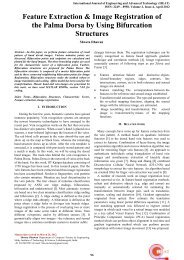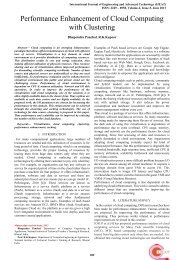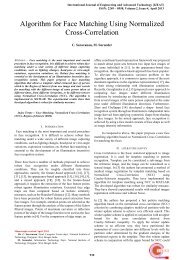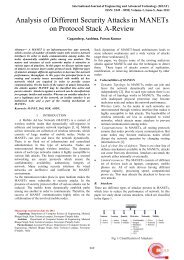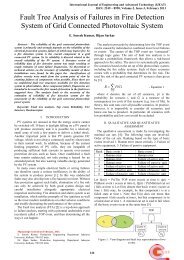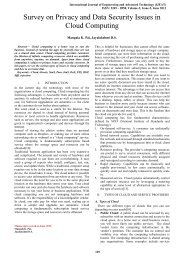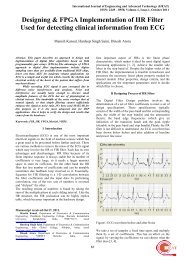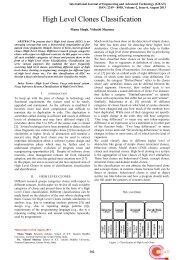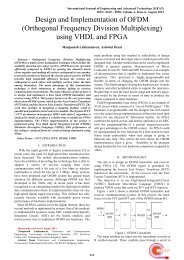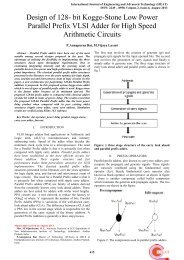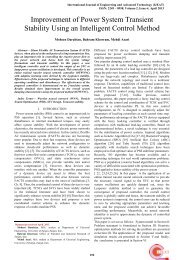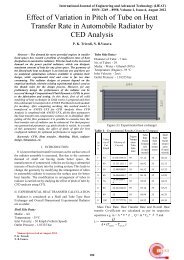A Research Paper on Hybrid Intrusion Detection System
A Research Paper on Hybrid Intrusion Detection System
A Research Paper on Hybrid Intrusion Detection System
Create successful ePaper yourself
Turn your PDF publications into a flip-book with our unique Google optimized e-Paper software.
Internati<strong>on</strong>al Journal of Engineering and Advanced Technology (IJEAT)<br />
ISSN: 2249 – 8958, Volume-2, Issue-4, April 2013<br />
A <str<strong>on</strong>g>Research</str<strong>on</strong>g> <str<strong>on</strong>g>Paper</str<strong>on</strong>g> <strong>on</strong> <strong>Hybrid</strong> Intrusi<strong>on</strong> Detecti<strong>on</strong><br />
<strong>System</strong><br />
Amit Kumar, Harish Chandra Maurya, Rahul Misra<br />
Absrtact- An intrusi<strong>on</strong> detecti<strong>on</strong> system (IDS) is a device or<br />
software applicati<strong>on</strong> that m<strong>on</strong>itors network or system activities<br />
for malicious activities or policy violati<strong>on</strong>s and produces reports<br />
to a Management Stati<strong>on</strong>. Some systems may attempt to stop an<br />
intrusi<strong>on</strong> attempt but this is neither required nor expected of a<br />
m<strong>on</strong>itoring system. Intrusi<strong>on</strong> detecti<strong>on</strong> and preventi<strong>on</strong> systems<br />
(IDPS) are primarily focused <strong>on</strong> identifying possible incidents,<br />
logging informati<strong>on</strong> about them, and reporting attempts. In<br />
additi<strong>on</strong>, organizati<strong>on</strong>s use IDPSes for other purposes, such as<br />
identifying problems with security policies, documenting existing<br />
threats and deterring individuals from violating security policies.<br />
IDPSes have become a necessary additi<strong>on</strong> to the security<br />
infrastructure of nearly every organizati<strong>on</strong>. Different methods<br />
can be used to detect intrusi<strong>on</strong>s which make a number of<br />
assumpti<strong>on</strong>s that are specific <strong>on</strong>ly to the particular method.<br />
Hence, in additi<strong>on</strong> to the definiti<strong>on</strong> of the security policy and the<br />
access patterns which are used in the learning phase of the<br />
detector, the attack detecti<strong>on</strong> capability of an intrusi<strong>on</strong> detecti<strong>on</strong><br />
system also depends up<strong>on</strong> the assumpti<strong>on</strong>s made by individual<br />
methods for intrusi<strong>on</strong> detecti<strong>on</strong>. The purpose of an intrusi<strong>on</strong><br />
detecti<strong>on</strong> system is to detect attacks. However, it is equally<br />
important to detect attacks at an early stage in order to minimize<br />
their impact. I have used Dataset and Classifier to refine<br />
Intruders in Networks.<br />
Keywords- (IDS), (IDPS), IDPSes.<br />
I. INTRODUCTION<br />
In the 21st century the development of telecommunicati<strong>on</strong>s<br />
networks has taken giant leaps from circuit and packet<br />
switched networks towards all-IP based networks. This<br />
development has created a unified envir<strong>on</strong>ment where<br />
communicati<strong>on</strong> of applicati<strong>on</strong>s and services (data and voice)<br />
are being transferred <strong>on</strong> top of the IP-protocol.<br />
Although the development of communicati<strong>on</strong> networks has<br />
been towards a better sustainability of technologies it has<br />
also raised new unwanted possibilities. Threats that were<br />
applicable <strong>on</strong>ly in the fixed networks are now feasible in the<br />
radio access networks. When taken into account that threats<br />
are becoming more and more sophisticated it also means<br />
that the security systems have to become more intelligent.<br />
The basic security measurements such as firewalls and<br />
antivirus scanners are in their limits to cope with the<br />
overgrowing number of intelligent attacks from the Internet.<br />
A soluti<strong>on</strong> to enhance the overall security of the networks is<br />
to increase the security layers with intrusi<strong>on</strong> detecti<strong>on</strong><br />
systems.<br />
To understand what role intrusi<strong>on</strong> detecti<strong>on</strong> has in<br />
telecommunicati<strong>on</strong>s networks it can be thought through a<br />
simple example.<br />
Manuscript received April, 2013.<br />
Amit Kumar, M.Tech 2 nd Year, Bhagwant University,Ajmer, India.<br />
Harish Chandra Maurya, Asst.Professor, Bhagwant University,Ajmer,<br />
India.<br />
Rahul Misra, M.Tech 2 nd Year, Bhagwant University,Ajmer, India.<br />
Think of intrusi<strong>on</strong> detecti<strong>on</strong> as a security guard that is<br />
guarding the fr<strong>on</strong>t gate of a factory premises.<br />
The premises of the factory represent the network of a<br />
mobile operator and the fence surrounding the factory is the<br />
operator’s firewall. Employees of the factory represent the<br />
traffic in the operator’s network. It is know that factories are<br />
well protected and they do not want to let people inside the<br />
premises that do not have the required clearances. The fence<br />
or firewall in this case, is in charge to keep all unwanted<br />
visitors outside the factory premises. Just like in a firewall, a<br />
fence has holes (gates) in it to let employees move in and<br />
out of the factory premises. These holes in the fence though<br />
leave the factory vulnerable to the unwanted visitors and this<br />
is why the factory has a security guard guarding the gate.<br />
Depending <strong>on</strong> the role that the security guard is in, while he<br />
is m<strong>on</strong>itoring the people going in and out of the factory<br />
premises, he either notifies the head of security when he<br />
detects a suspicious looking pers<strong>on</strong> walking through the<br />
gate. Or he steps in and prevents this pers<strong>on</strong> from entering<br />
the factory premises. The basic functi<strong>on</strong>ality of an intrusi<strong>on</strong><br />
detecti<strong>on</strong> system is the first example of the security guard.<br />
IDS generate an alarm when it detects something suspicious<br />
and then the security pers<strong>on</strong>nel of the network operator<br />
further investigate the cause of the alarm. An intrusi<strong>on</strong><br />
detecti<strong>on</strong> system (IDS) is a device, typically a designated<br />
computer system, which m<strong>on</strong>itors activity to identify<br />
malicious or suspicious alerts. It is placed inside an<br />
organisati<strong>on</strong> to m<strong>on</strong>itor what occurs within the network of<br />
the organisati<strong>on</strong>. The goal of an intrusi<strong>on</strong> detecti<strong>on</strong> system<br />
is to accurately detect computer security incidents, and<br />
notify network administrators. A distincti<strong>on</strong> is made<br />
between alerts and incidents by an intrusi<strong>on</strong> detecti<strong>on</strong><br />
system. Alerts are defined as all the observable acti<strong>on</strong>s <strong>on</strong><br />
the computer network that are picked up by the sensors of an<br />
intrusi<strong>on</strong> detecti<strong>on</strong> system. Incidents are malicious or<br />
suspicious alerts that have a high enough value to be<br />
c<strong>on</strong>sidered a security-relevant system event in which the<br />
system’s security policy is disobeyed or otherwise breached.<br />
An IDS c<strong>on</strong>sists of four comp<strong>on</strong>ents, according to the<br />
Comm<strong>on</strong> Intrusi<strong>on</strong> Detecti<strong>on</strong> Framework (CIDF); event<br />
generators, analysers, event databases and resp<strong>on</strong>se units. In<br />
the research of this thesis, Dataset is used to provide attacks<br />
and normal data to analyzer. An effort will be made to<br />
choose a machine learning method that can be used as an<br />
analyser, which improves the detecti<strong>on</strong> rate alerts from<br />
incidents. An event database will be used to train the<br />
analyser, and to evaluate its predicti<strong>on</strong>s. The resp<strong>on</strong>se units<br />
will not be within the scope of this thesis, but can be<br />
c<strong>on</strong>trolled by the decisi<strong>on</strong>s of the analyser.<br />
II. INTRUSION DETECTION AND INTRUSION<br />
DETECTION SYSTEM<br />
The intrusi<strong>on</strong> detecti<strong>on</strong> systems are a critical comp<strong>on</strong>ent in<br />
the network security arsenal.<br />
294
A <str<strong>on</strong>g>Research</str<strong>on</strong>g> <str<strong>on</strong>g>Paper</str<strong>on</strong>g> <strong>on</strong> <strong>Hybrid</strong> Intrusi<strong>on</strong> Detecti<strong>on</strong> <strong>System</strong><br />
2.1 Principles and Assumpti<strong>on</strong>s in Intrusi<strong>on</strong> Detecti<strong>on</strong><br />
Denning defines the principle for characterizing a system<br />
under attack. The principle states that for a system which is<br />
not under attack, the following three c<strong>on</strong>diti<strong>on</strong>s hold true:<br />
1. Acti<strong>on</strong>s of users c<strong>on</strong>form to statistically predictable<br />
patterns.<br />
2. Acti<strong>on</strong>s of users do not include sequences which violate<br />
the security policy.<br />
3. Acti<strong>on</strong>s of every process corresp<strong>on</strong>d to a set of<br />
specificati<strong>on</strong>s which describe what the process is<br />
allowed to do.<br />
<strong>System</strong>s under attack do not meet at least <strong>on</strong>e of the three<br />
c<strong>on</strong>diti<strong>on</strong>s. Further, intrusi<strong>on</strong> detecti<strong>on</strong> is based up<strong>on</strong> some<br />
assumpti<strong>on</strong>s which are true regardless of the approach<br />
adopted by the intrusi<strong>on</strong> detecti<strong>on</strong> system. These<br />
assumpti<strong>on</strong>s are:<br />
1. There exists a security policy which defines the normal<br />
and (or) the abnormal usage of every resource.<br />
2. The patterns generated during the abnormal system<br />
usage are different from the patterns generated during<br />
the normal usage of the system; i.e., the abnormal and<br />
normal usage of a system results in different system<br />
behavior. This difference in behavior can be used to<br />
detect intrusi<strong>on</strong>s.<br />
As we shall discuss later, different methods can be used to<br />
detect intrusi<strong>on</strong>s which make a number of assumpti<strong>on</strong>s that<br />
are specific <strong>on</strong>ly to the particular method. Hence, in additi<strong>on</strong><br />
to the definiti<strong>on</strong> of the security policy and the access<br />
patterns which are used in the learning phase of the detector,<br />
the attack detecti<strong>on</strong> capability of an intrusi<strong>on</strong> detecti<strong>on</strong><br />
system also depends up<strong>on</strong> the assumpti<strong>on</strong>s made by<br />
individual methods for intrusi<strong>on</strong> detecti<strong>on</strong>.<br />
2.2 Comp<strong>on</strong>ents of Intrusi<strong>on</strong> Detecti<strong>on</strong> <strong>System</strong>s<br />
An intrusi<strong>on</strong> detecti<strong>on</strong> system typically c<strong>on</strong>sists of three sub<br />
systems or comp<strong>on</strong>ents:<br />
1. Data Preprocessor – Data preprocessor is resp<strong>on</strong>sible<br />
for collecting and providing the audit data (in a<br />
specified form) that will be used by the next comp<strong>on</strong>ent<br />
(analyzer) to make a decisi<strong>on</strong>. Data preprocessor is,<br />
thus, c<strong>on</strong>cerned with collecting the data from the<br />
desired source and c<strong>on</strong>verting it into a format that is<br />
comprehensible by the analyzer.Data used for detecting<br />
intrusi<strong>on</strong>s range from user access patterns (for example,<br />
the sequence of commands issued at the terminal and<br />
the resources requested) to network packet level<br />
features (such as the source and destinati<strong>on</strong> IP<br />
addresses, type of packets and rate of occurrence of<br />
packets) to applicati<strong>on</strong> and system level behavior (such<br />
as the sequence of system calls generated by a process.)<br />
We refer to this data as the audit patterns.<br />
2. Analyzer (Intrusi<strong>on</strong> Detector) – The analyzer or the<br />
intrusi<strong>on</strong> detector is the core comp<strong>on</strong>ent which analyzes<br />
the audit patterns to detect attacks. This is a critical<br />
comp<strong>on</strong>ent and <strong>on</strong>e of the most researched. Various<br />
pattern matching, machine learning, data mining and<br />
statistical techniques can be used as intrusi<strong>on</strong> detectors.<br />
The capability of the analyzer to detect an attack often<br />
determines the strength of the overall system.<br />
3. Resp<strong>on</strong>se Engine – The resp<strong>on</strong>se engine c<strong>on</strong>trols the<br />
reacti<strong>on</strong> mechanism and determines how to resp<strong>on</strong>d<br />
when the analyzer detects an attack. The system may<br />
decide either to raise an alert without taking any acti<strong>on</strong><br />
against the source or may decide to block the source for<br />
a predefined period of time. Such an acti<strong>on</strong> depends<br />
up<strong>on</strong> the predefined security policy of the network<br />
The authors define the Comm<strong>on</strong> Intrusi<strong>on</strong> Detecti<strong>on</strong><br />
Framework (CIDF) which recognizes a comm<strong>on</strong><br />
architecture for intrusi<strong>on</strong> detecti<strong>on</strong> systems. The CIDF<br />
defines four comp<strong>on</strong>ents that are comm<strong>on</strong> to any intrusi<strong>on</strong><br />
detecti<strong>on</strong> system. The four comp<strong>on</strong>ents are; Event<br />
generators (E-boxes), event Analyzers (A-boxes), event<br />
Databases (D-boxes) and the Resp<strong>on</strong>se units (R-boxes). The<br />
additi<strong>on</strong>al comp<strong>on</strong>ent, called the D-boxes, is opti<strong>on</strong>al and<br />
can be used for later analysis.<br />
III. PROPOSED WORK<br />
We use two classificati<strong>on</strong> techniques for our proposed<br />
architecture, in a combined manner. C<strong>on</strong>sequently, an<br />
increasing number of approaches have been developed for<br />
accomplishing such purpose, including k-nearest-neighbor<br />
(KNN) classificati<strong>on</strong>, Naïve Bayes classificati<strong>on</strong>, support<br />
vector machines (SVM), decisi<strong>on</strong> tree (DT), neural network<br />
(NN), and maximum entropy. Our choice am<strong>on</strong>g all<br />
available classificati<strong>on</strong> techniques is depends up<strong>on</strong> our<br />
studies about all classifier. We put our motivati<strong>on</strong>s for these<br />
classifiers in below topic at a glance.<br />
3.1 Bayes’ Theorem<br />
Let X be a data tuple. In Bayesian terms, X is c<strong>on</strong>sidered<br />
“evidence.” As usual, it is described by measurements made<br />
<strong>on</strong> a set of n attributes. Let H be some hypothesis, such as<br />
that the data tuple X bel<strong>on</strong>gs to a specified class C. For<br />
classificati<strong>on</strong> problems, we want to determine P (H│X), the<br />
probability that the hypothesis H holds given the “evidence”<br />
or observed data tuple X. In other words, we are looking for<br />
the probability that tuple X bel<strong>on</strong>gs to class C, given that we<br />
know the attribute descripti<strong>on</strong> of X. P (H│X) is the posterior<br />
probability, or a posteriori probability, of H c<strong>on</strong>diti<strong>on</strong>ed <strong>on</strong><br />
X.<br />
In this way, Bayes’ theorem adjusts the probabilities as new<br />
informati<strong>on</strong> <strong>on</strong> evidences appears.<br />
According to its classical formulati<strong>on</strong>, given two events A<br />
and B, the c<strong>on</strong>diti<strong>on</strong>al probability<br />
P(A|B) that A occurs if B occurs can be obtained if we<br />
know<br />
P(A), the probability that A occurs<br />
P(B), the probability that B occurs,<br />
P(B|A) the c<strong>on</strong>diti<strong>on</strong>al probability of B given A,<br />
(As shown in equati<strong>on</strong>):<br />
3.1.2 Naïve Bayes Classifier for intrusi<strong>on</strong> Detecti<strong>on</strong><br />
In Bayesian classificati<strong>on</strong>, we have a hypothesis that the<br />
given data bel<strong>on</strong>gs to a particular class. We then calculate<br />
the probability for the hypothesis to be true. This is am<strong>on</strong>g<br />
the most practical approaches for certain types of problems.<br />
The approach requires <strong>on</strong>ly <strong>on</strong>e scan of the whole data.<br />
Also, if at some stage there are additi<strong>on</strong>al training data, then<br />
each training example can incrementally increase/decrease<br />
the probability that a hypothesis is correct. Thus, a Bayesian<br />
network is used to model a domain c<strong>on</strong>taining uncertainty .<br />
3.2 K-means Clustering<br />
The k-means algorithm takes the input parameter, k, and<br />
partiti<strong>on</strong>s a set of n objects into k clusters so that the<br />
resulting intra-cluster similarity is high but the inter-cluster<br />
similarity is low. Cluster similarity is measured in regard to<br />
295
Internati<strong>on</strong>al Journal of Engineering and Advanced Technology (IJEAT)<br />
ISSN: 2249 – 8958, Volume-2, Issue-4, April 2013<br />
the mean value of the objects in a cluster, which can be<br />
viewed as the cluster’s centroid or center of gravity.<br />
Network intrusi<strong>on</strong> class labels are divided into four main<br />
classes, which are DoS, Probe, U2R, and R2L. Fig. 1(a) to<br />
Fig. 1(c) shows the steps involved in K-Means clustering<br />
process. Fig.2 will later show the final overall result with<br />
applicati<strong>on</strong> of the classificati<strong>on</strong> approach. The main goal to<br />
utilize K-Means clustering approach is to split and to group<br />
data into normal and attack instances.K-Means clustering<br />
methods partiti<strong>on</strong> the input dataset into k- clusters according<br />
to an initial value known as the seed-points into each<br />
cluster’s centroids or cluster centers. The mean value of<br />
numerical data c<strong>on</strong>tained within each cluster is called<br />
centroids. In our case, we choose k = 3 in order to cluster the<br />
data into three clusters (C1, C2, C3). Since U2R and R2L<br />
attack patterns are naturally quite similar with normal<br />
instances, <strong>on</strong>e extra cluster is used to group U2R and R2L<br />
attacks.<br />
Back to Fig. 1(b), each input will be assigned to the closest<br />
Centroid by squared distances between the input data points<br />
and the centroids. New centroids will then be generated for<br />
each cluster by calculating the mean values of the input set<br />
assigned to each cluster as shown in Fig. 1(c).<br />
(a) (b) (c)<br />
Algorithm: k-means. The k-means algorithm for<br />
partiti<strong>on</strong>ing, where each cluster’s center is represented by<br />
the mean value of the objects in the cluster.<br />
Input:<br />
k: the number of clusters,<br />
D: a data set c<strong>on</strong>taining n objects.<br />
Output: A set of k clusters.<br />
Method:<br />
(1) Arbitrarily choose k objects from D as the initial cluster<br />
centers;<br />
(2) Repeat<br />
(3) (Re) assign each object to the cluster to which the<br />
object is the most similar, based <strong>on</strong> the mean value of<br />
the objects in the cluster;<br />
(4) Update the cluster means, i.e., calculate the mean value<br />
of the objects for each cluster;<br />
(5) Until no change;<br />
Figure 3.2: block diagram for K-means clustering<br />
IV. FUTURE SCOPE<br />
In the future:<br />
We recommend c<strong>on</strong>sidering the <strong>Hybrid</strong> Intrusi<strong>on</strong><br />
Detecti<strong>on</strong> <strong>System</strong> which is better at detecting R2L and<br />
U2R attacks.<br />
The misuse detecti<strong>on</strong> approach better at detecting R2L<br />
and U2R attacks more efficiently as well as anomaly<br />
detecti<strong>on</strong> approach.<br />
Work for approach which is better at detecting attacks<br />
at the absence of match signatures as provided in the<br />
misuse rule files.<br />
The critical nature of the task of detecting intrusi<strong>on</strong>s in<br />
networks and applicati<strong>on</strong>s leaves no margin for errors. The<br />
effective cost of a successful intrusi<strong>on</strong> overshadows the cost<br />
of developing intrusi<strong>on</strong> detecti<strong>on</strong> systems and hence, it<br />
becomes critical to identify the best possible approach for<br />
developing better intrusi<strong>on</strong> detecti<strong>on</strong> systems.<br />
Every network and applicati<strong>on</strong> is custom designed and it<br />
becomes extremely difficult to develop a single soluti<strong>on</strong><br />
which can work for every network and applicati<strong>on</strong>. In this<br />
thesis, we proposed novel frameworks and developed<br />
methods which perform better. However, in order to<br />
improve the overall performance of our system we used the<br />
domain knowledge for selecting better features for training<br />
our models. This is justified because of the critical nature of<br />
the task of intrusi<strong>on</strong> detecti<strong>on</strong>. Using domain knowledge to<br />
develop better systems is not a significant disadvantage;<br />
however, developing completely automatic systems presents<br />
an interesting directi<strong>on</strong> for future research.<br />
The field of intrusi<strong>on</strong> detecti<strong>on</strong> has been around since<br />
1980’s and a lot of advancement has been made in the same.<br />
However, to keep pace with the rapid and ever changing<br />
networks and applicati<strong>on</strong>s, the research in intrusi<strong>on</strong><br />
detecti<strong>on</strong> must synchr<strong>on</strong>ize with the present networks.<br />
Present networks increasingly support wireless technologies,<br />
removable and mobile devices. Intrusi<strong>on</strong> detecti<strong>on</strong> systems<br />
must integrate with such networks and devices and provide<br />
support for advances in a comprehensible manner.<br />
REFERENCES<br />
[1] Stefan Axelss<strong>on</strong>. <str<strong>on</strong>g>Research</str<strong>on</strong>g> in Intrusi<strong>on</strong>-Detecti<strong>on</strong> <strong>System</strong>s: A<br />
Survey. Technical Report 98-17, Department of Computer<br />
Engineering, Chalmers University of Technology, 1998.<br />
[2] SANS Institute - Intrusi<strong>on</strong> Detecti<strong>on</strong> FAQ. Last accessed: August<br />
30, 2012. http://www.sans.org/resources/idfaq/.<br />
[3] Kotagiri Ramamohanarao, Kapil Kumar Gupta, Tao Peng, and<br />
Christopher Leckie. The Curse of Ease of Access to the Internet. In<br />
Proceedings of the 3 rd Internati<strong>on</strong>al C<strong>on</strong>ference <strong>on</strong> Informati<strong>on</strong><br />
<strong>System</strong>s Security (ICISS), pages 234–249. Lecture Notes in<br />
Computer Science, Springer Verlag, Vol (4812), 2008.<br />
[4] Overview of Attack Trends, 2002. Last accessed: November 30,<br />
2008. http://www. cert.org/archive/pdf/attack_trends.pdf.<br />
[5] Kapil Kumar Gupta, Baikunth Nath, Kotagiri Ramamohanarao, and<br />
Ashraf Kazi. Attacking C<strong>on</strong>fidentiality: An Agent Based Approach.<br />
In Proceedings of IEEE Internati<strong>on</strong>al C<strong>on</strong>ference <strong>on</strong> Intelligence and<br />
Security Informatics, pages 285–296. Lecture Notes in Computer<br />
Science, Springer Verlag, Vol (3975), 2006.<br />
[6] The ISC Domain Survey. Last accessed: Novmeber 30, 2008.<br />
https://www.isc. org/soluti<strong>on</strong>s/survey/.<br />
[7] Peter Lyman, Hal R. Varian, Peter Charles, Nathan Good, Laheem<br />
Lamar Jordan, Joyojeet Pal, and Kirsten Swearingen. How much<br />
Informati<strong>on</strong>. Last accessed: Novmeber 30, 2008.<br />
http://www2.sims.berkeley.edu/research/projects/how-much-info-<br />
2003.<br />
[8] Animesh Patcha and Jung-Min Park. An Overview of Anomaly<br />
Detecti<strong>on</strong> Techniques: Existing Soluti<strong>on</strong>s and Latest Technological<br />
Trends. Computer Networks, 51(12):3448–3470, 2007.<br />
[9] CERT/CC Statistics. Last accessed: Novmeber 30, 2008.<br />
http://www.cert.org/stats/.<br />
296
A <str<strong>on</strong>g>Research</str<strong>on</strong>g> <str<strong>on</strong>g>Paper</str<strong>on</strong>g> <strong>on</strong> <strong>Hybrid</strong> Intrusi<strong>on</strong> Detecti<strong>on</strong> <strong>System</strong><br />
[10] Thomas A. L<strong>on</strong>gstaff, James T. Ellis, Shawn V. Hernan, Howard F.<br />
Lips<strong>on</strong>, Robert D. Mcmillan, Linda Hutz Pesante, and Derek<br />
Simmel. Security of the Internet. Technical Report The<br />
Froehlich/Kent Encyclopedia of Telecommunicati<strong>on</strong>s Vol (15),<br />
CERT Coordinati<strong>on</strong> Center 1997. Last accessed: Novmeber 30,<br />
2008. http://www.cert.org/encyc_article/tocencyc.html.<br />
[11] KDD Cup 1999 Intrusi<strong>on</strong> Detecti<strong>on</strong> Data. Last accessed: Novmeber<br />
30, 2008. http:<br />
//kdd.ics.uci.edu/databases/kddcup99/kddcup99.html.<br />
[12] Kapil Kumar Gupta, Baikunth Nath, and Kotagiri Ramamohanarao.<br />
Applicatio base Intrusi<strong>on</strong> Detecti<strong>on</strong> Dataset. Last accessed:<br />
Novmeber 30, 2008. http://www.csseunimelb.edu.au/˜kgupta.<br />
[13] Stefan Axelss<strong>on</strong>. Intrusi<strong>on</strong> Detecti<strong>on</strong> <strong>System</strong>s: A Taxomomy and<br />
Survey. Technical Report 99-15, Department of Computer<br />
Engineering, Chalmers University of Technology, 2000.<br />
[14] Anita K. J<strong>on</strong>es and Robert S. Sielken. Computer <strong>System</strong> Intrusi<strong>on</strong><br />
Detecti<strong>on</strong>: A Survey. Technical report, Department of Computer<br />
Science, University of Virginia, 1999. Last accessed:Novmeber 30,<br />
2008. http://www.cs.virginia.edu/˜j<strong>on</strong>es/IDSresearch/Documents/j<strong>on</strong>es-sielken-survey-v11.pdf.<br />
[15] Peyman Kabiri and Ali A. Ghorbani. <str<strong>on</strong>g>Research</str<strong>on</strong>g> <strong>on</strong> Intrusi<strong>on</strong><br />
Detecti<strong>on</strong> and Resp<strong>on</strong>se: A Survey. Internati<strong>on</strong>al Journal of<br />
Network Security, 1(2):84–102, 2005.<br />
[16] Joseph S. Sherif and Tommy G. Dearm<strong>on</strong>d. Intrusi<strong>on</strong> Detecti<strong>on</strong>:<br />
<strong>System</strong>s and Models. In Proceedings of the Eleventh IEEE<br />
Internati<strong>on</strong>al Workshops <strong>on</strong> Enabling Technologies: Infrastructure<br />
for Collaborative Enterprises. WET ICE, pages 115–133. IEEE,<br />
2002.<br />
[17] Mikko T. Sip<strong>on</strong>en and Harri Oinas-Kukk<strong>on</strong>en. A Review of<br />
Informati<strong>on</strong> Security Issues and Respective <str<strong>on</strong>g>Research</str<strong>on</strong>g> C<strong>on</strong>tributi<strong>on</strong>s.<br />
SIGMIS Database, 38(1):60–80, 2007. ACM.<br />
[18] Teresa F. Lunt. A survey of intrusi<strong>on</strong> detecti<strong>on</strong> techniques.<br />
Computers and Security, 12(4):405–418, 1993. Elsevier Advanced<br />
Technology Publicati<strong>on</strong>s.<br />
[19] Emilie Lundin and Erland J<strong>on</strong>ss<strong>on</strong>. Survey of Intrusi<strong>on</strong> Detecti<strong>on</strong><br />
<str<strong>on</strong>g>Research</str<strong>on</strong>g>. Technical Report 02-04, Department of Computer<br />
Engineering, Chalmers University of Technology, 2002.<br />
[20] James P. Anders<strong>on</strong>. Computer Security Threat M<strong>on</strong>itoring and<br />
Surveillance, 1980. Last accessed: Novmeber 30, 2011.<br />
http://csrc.nist.gov/publicati<strong>on</strong>s/ history/ande80.pdf.<br />
[21] Dorothy E. Denning. An Intrusi<strong>on</strong>-Detecti<strong>on</strong> Model. IEEE<br />
Transacti<strong>on</strong>s <strong>on</strong> Software Engineering, 13(2):222–232, 1987. IEEE.<br />
[22] H. S. Javitz and A. Valdes. The SRI IDES Statistical Anomaly<br />
Detector. In Proceedings of<br />
[23] the IEEE Symposium <strong>on</strong> Security and Privacy, pages 316–326.<br />
IEEE, 1991.<br />
[24] S.E.Smaha. Haystack: An Intrusi<strong>on</strong> Detecti<strong>on</strong> <strong>System</strong>. In<br />
Proceedings of the 4th Aerospace Computer Security Applicati<strong>on</strong>s<br />
C<strong>on</strong>ference, pages 37–44. IEEE, 1988.<br />
[25] Paul Innella. The Evoluti<strong>on</strong> of Intrusi<strong>on</strong> Detecti<strong>on</strong> <strong>System</strong>s, 2001.<br />
Last accessed: Novmeber 30, 2008.<br />
http://www.securityfocus.com/infocus/1514.<br />
297



